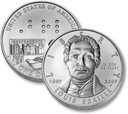Get a Mint-Fresh Louis Braille Bicentennial Silver Dollar
Now’s your chance to own a striking US Mint coin honoring the 200th anniversary of the birth of Louis Braille, the inventor of the Braille system used by the blind to read and write. One side pictures Louis Braille, and the other pictures a child reading a book in Braille. It shows the word “Brai... more
Get a Mint-Fresh Louis Braille Bicentennial Silver Dollar
Now’s your chance to own a striking US Mint coin honoring the 200th anniversary of the birth of Louis Braille, the inventor of the Braille system used by the blind to read and write. One side pictures Louis Braille, and the other pictures a child reading a book in Braille. It shows the word “Braille” in Braille. It’s the first US coin to ever feature readable Braille!
Born on January 4, 1809, in Coupvray, France, Louis Braille had an accident that left him blind by the age of four. When he was 10, he earned a scholarship to the Royal Institute for Blind Children in Paris, where he was the school’s youngest student. While there, a captain in the Army visited and introduced the students to “night writing,” which was used by soldiers in the field, enabling them to read orders without the use of lights. His system used 12 dots that represented words. Braille was intrigued and developed his own system using just six dots.
Braille developed the system that carries his name by the time he was 15. His system uses up to six dots to represent letters and includes a system for punctuation and contractions. Braille’s system was eventually adapted for nearly every language in the world and is used in a wide variety of places including bus stops, maps, text books, and more.
Add this important history to your collection today.
Less 












